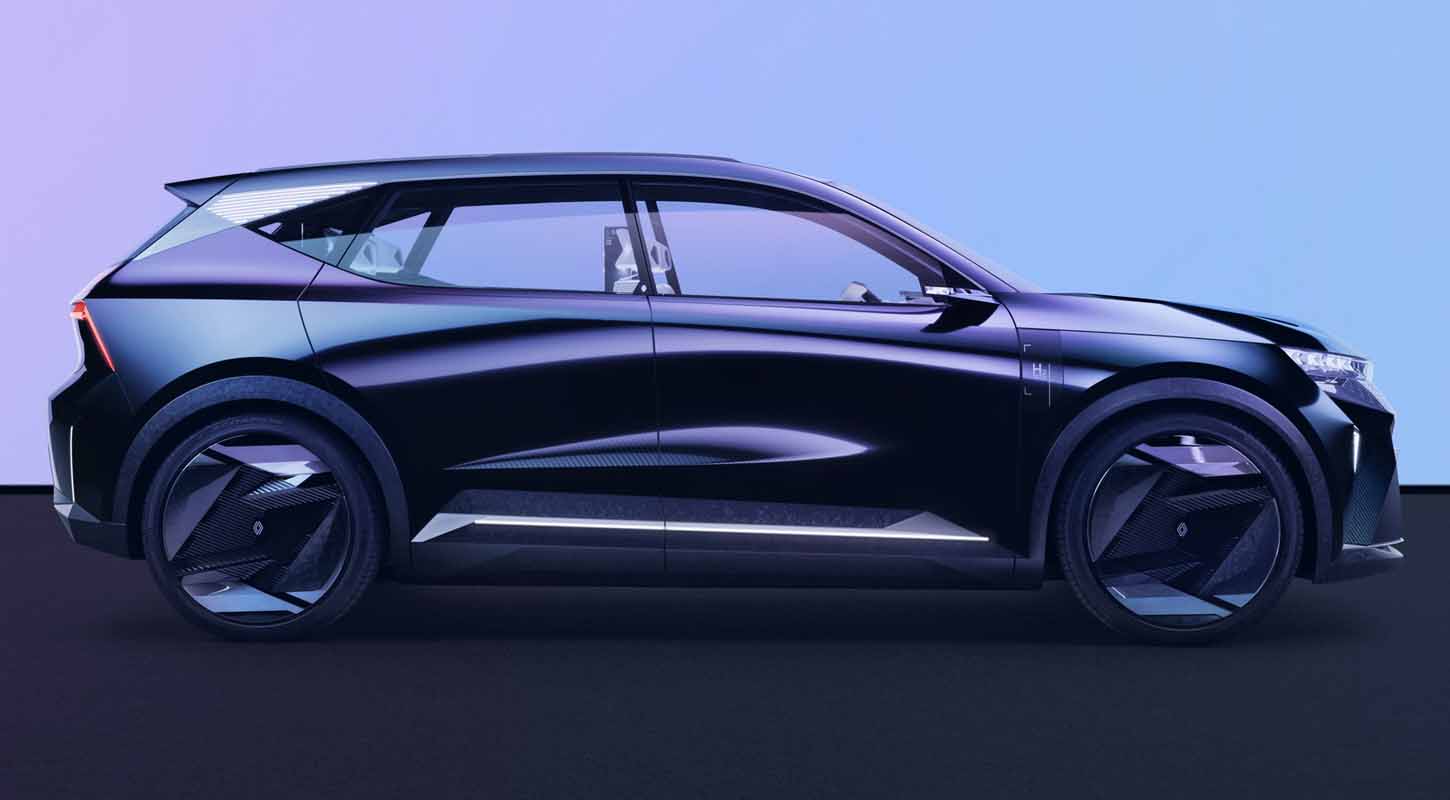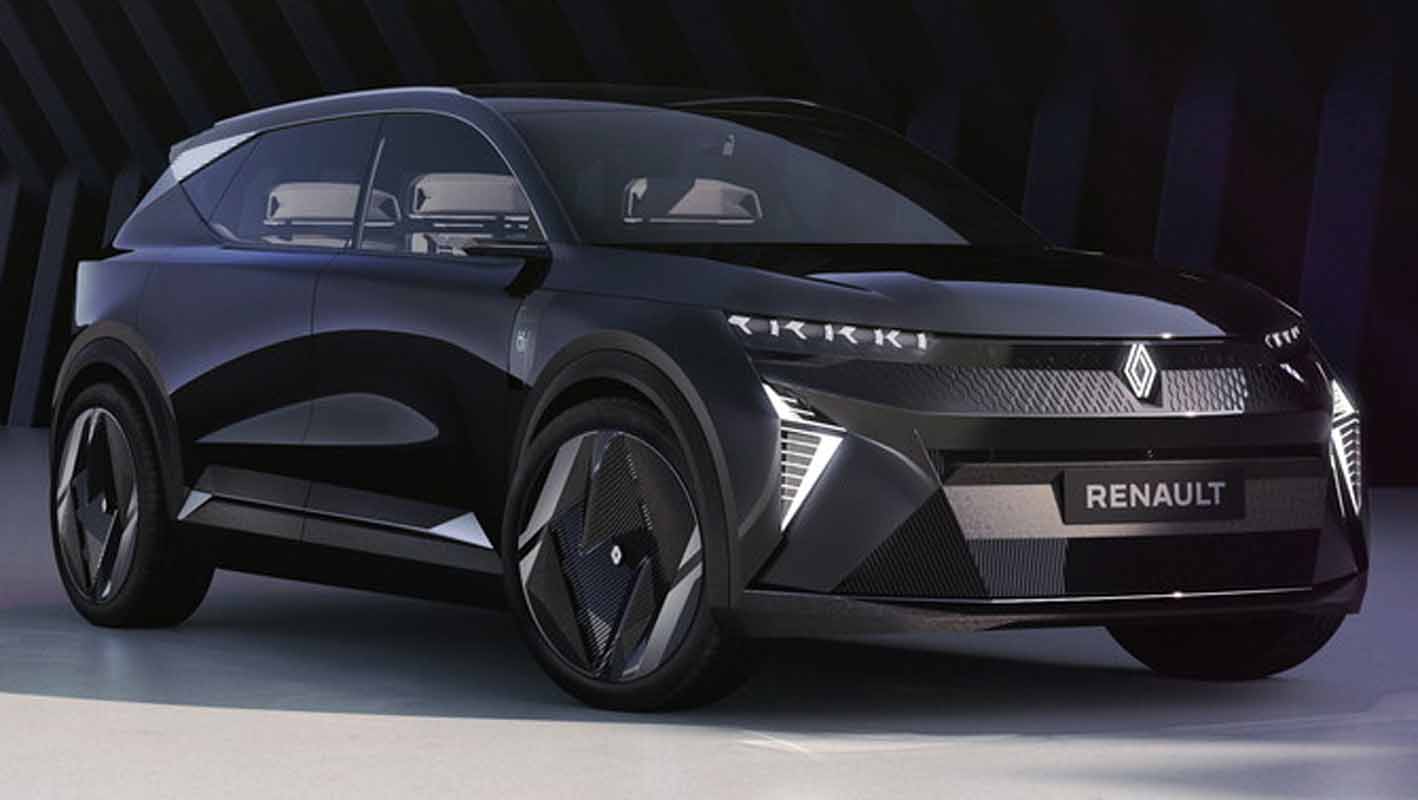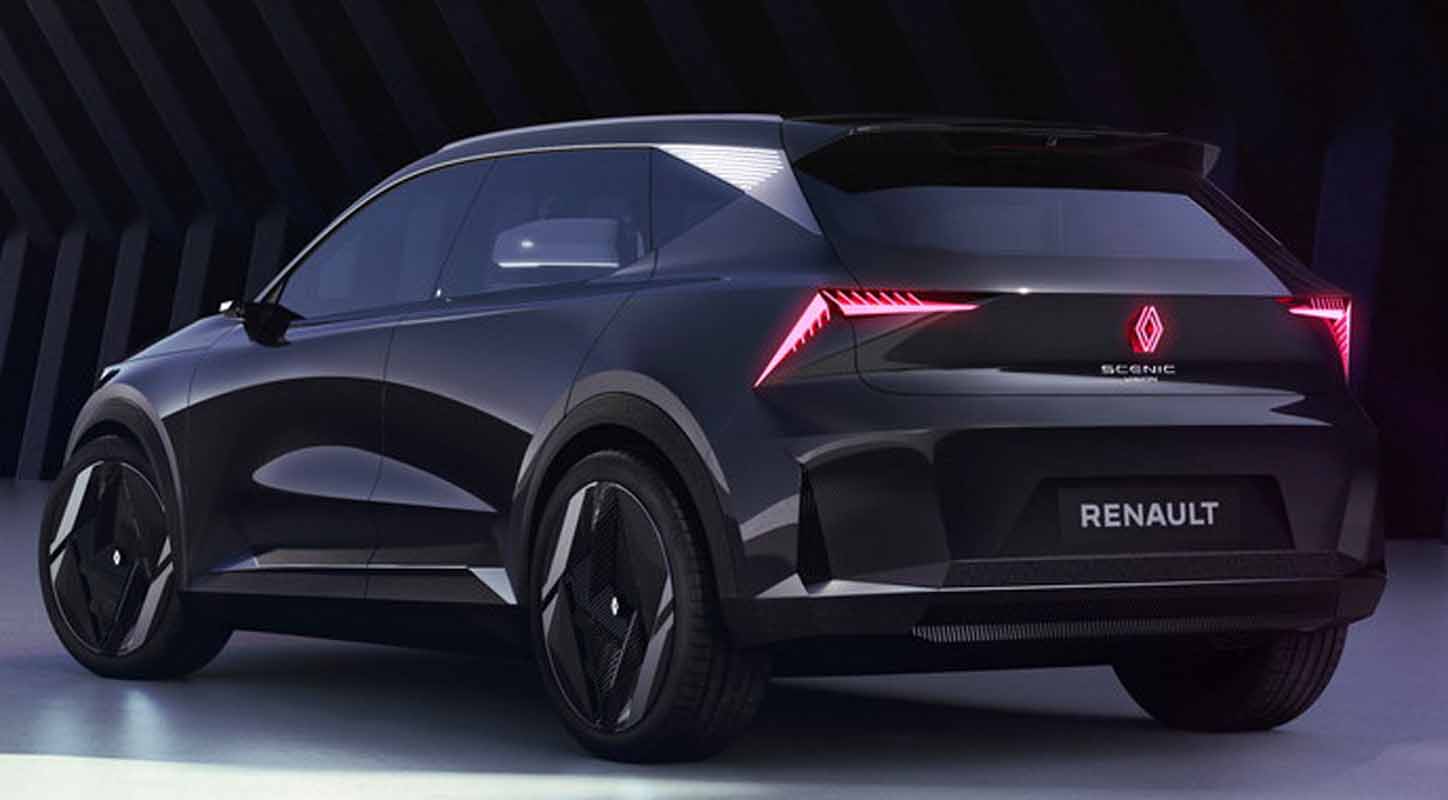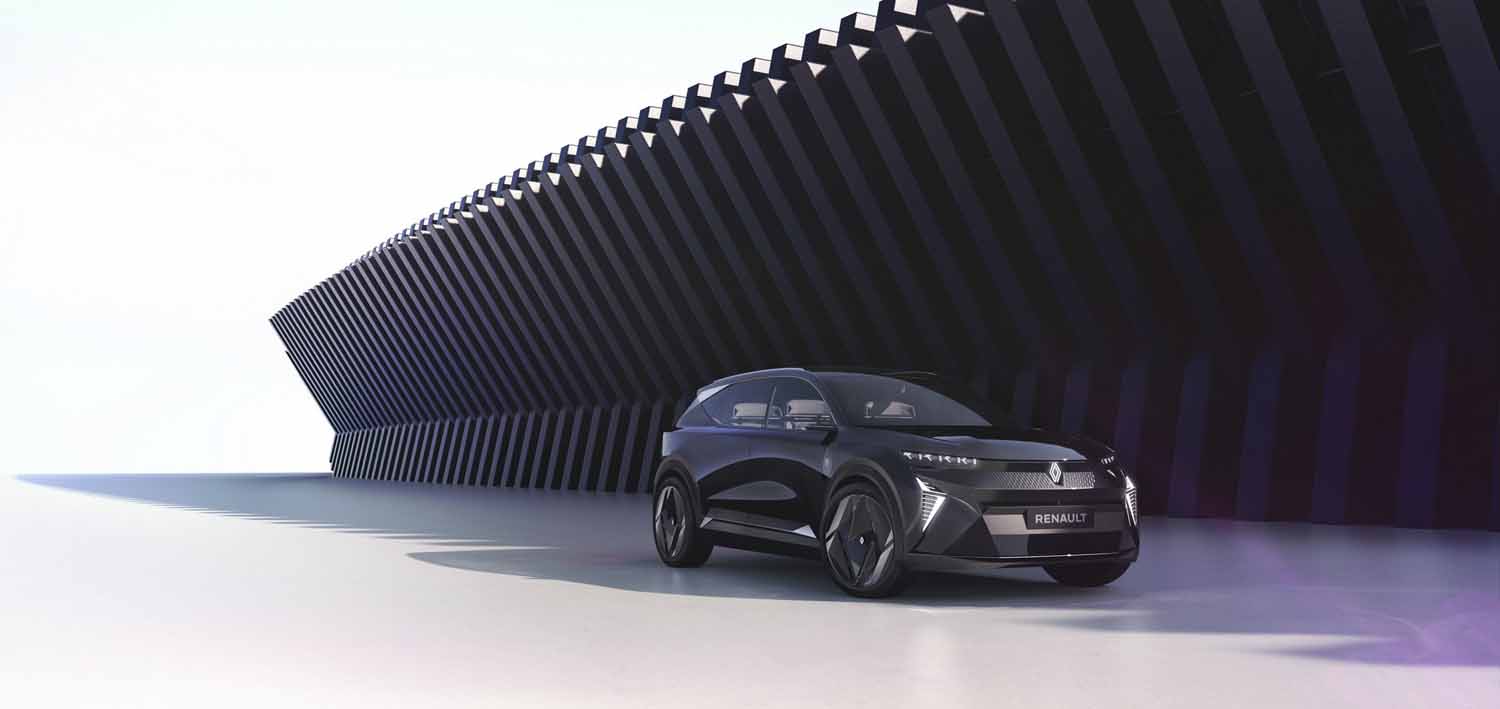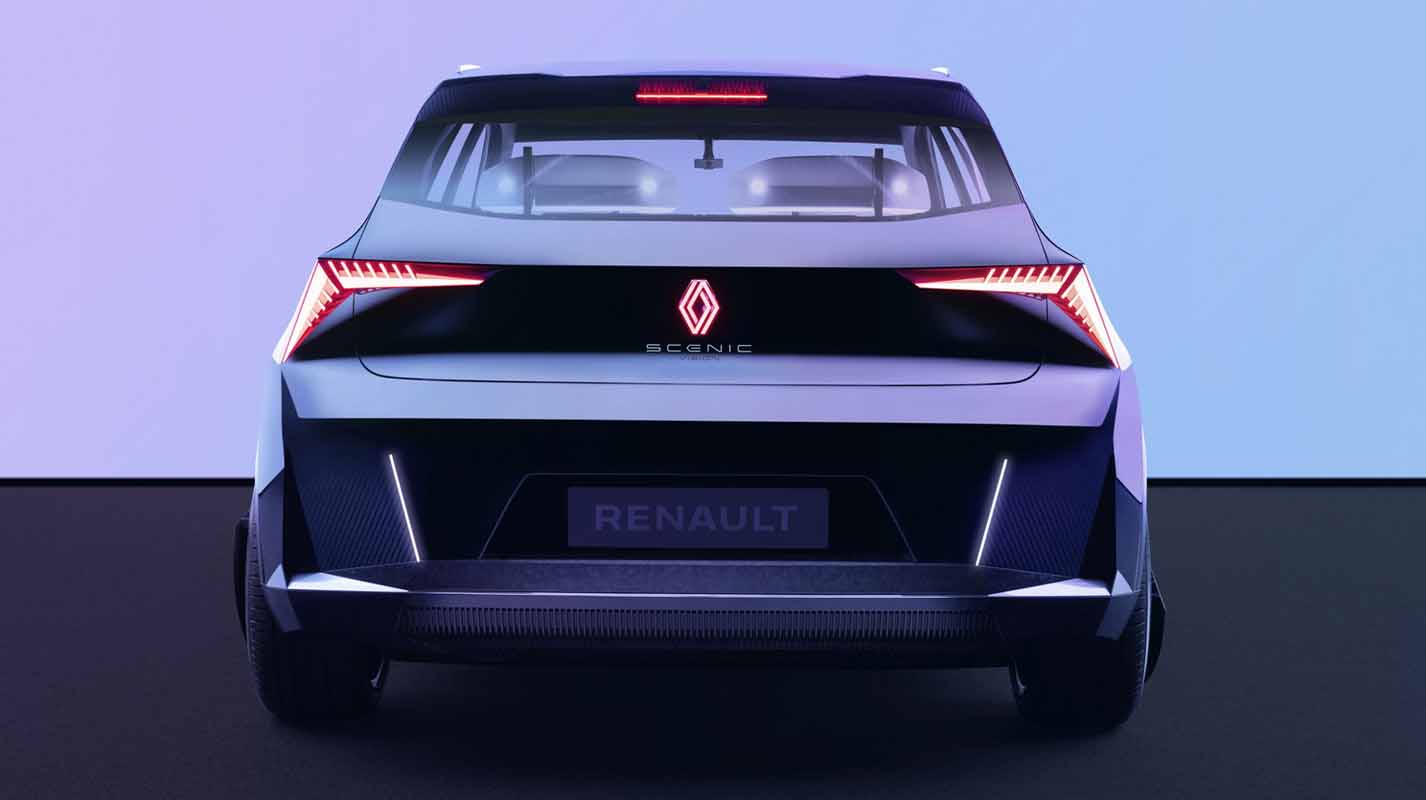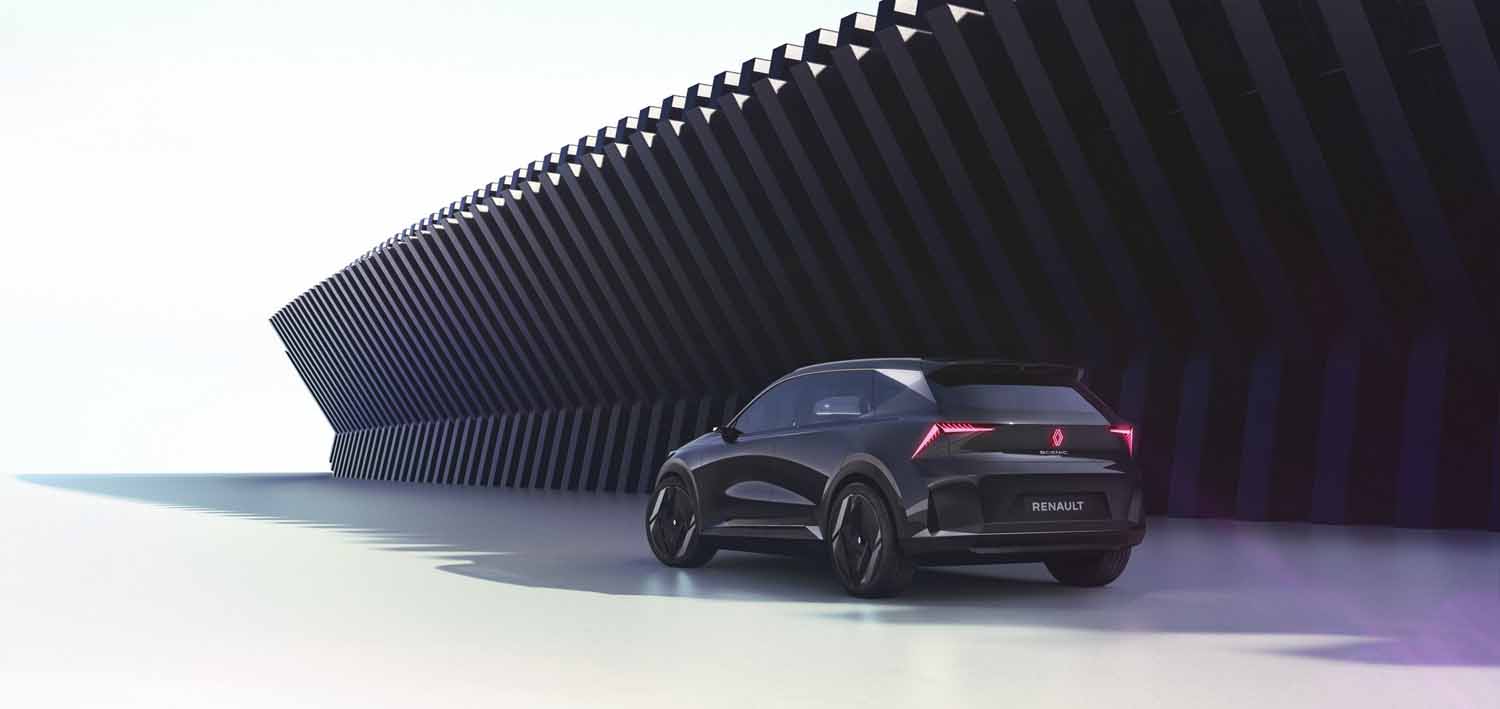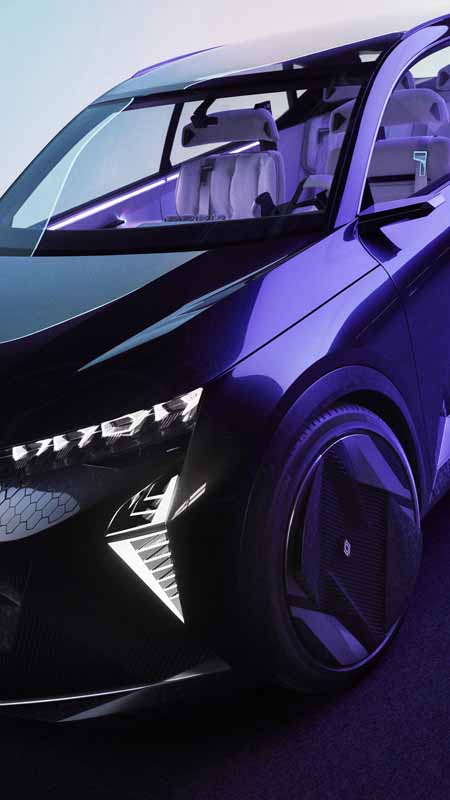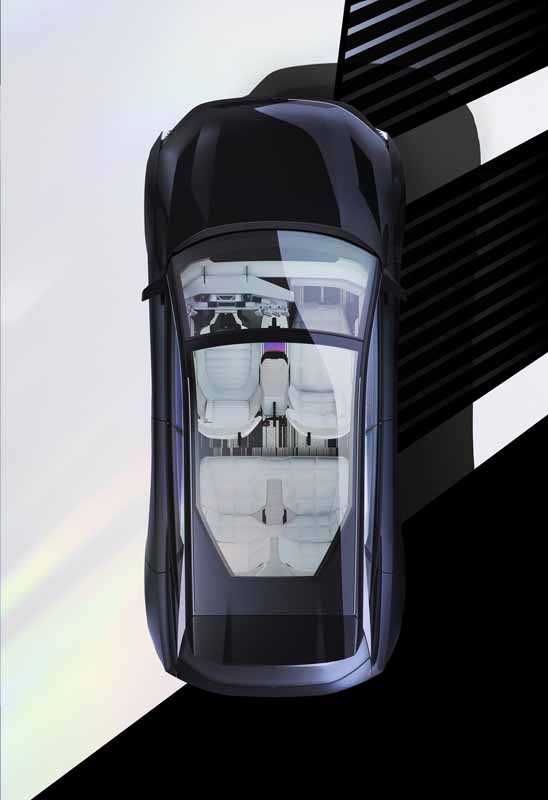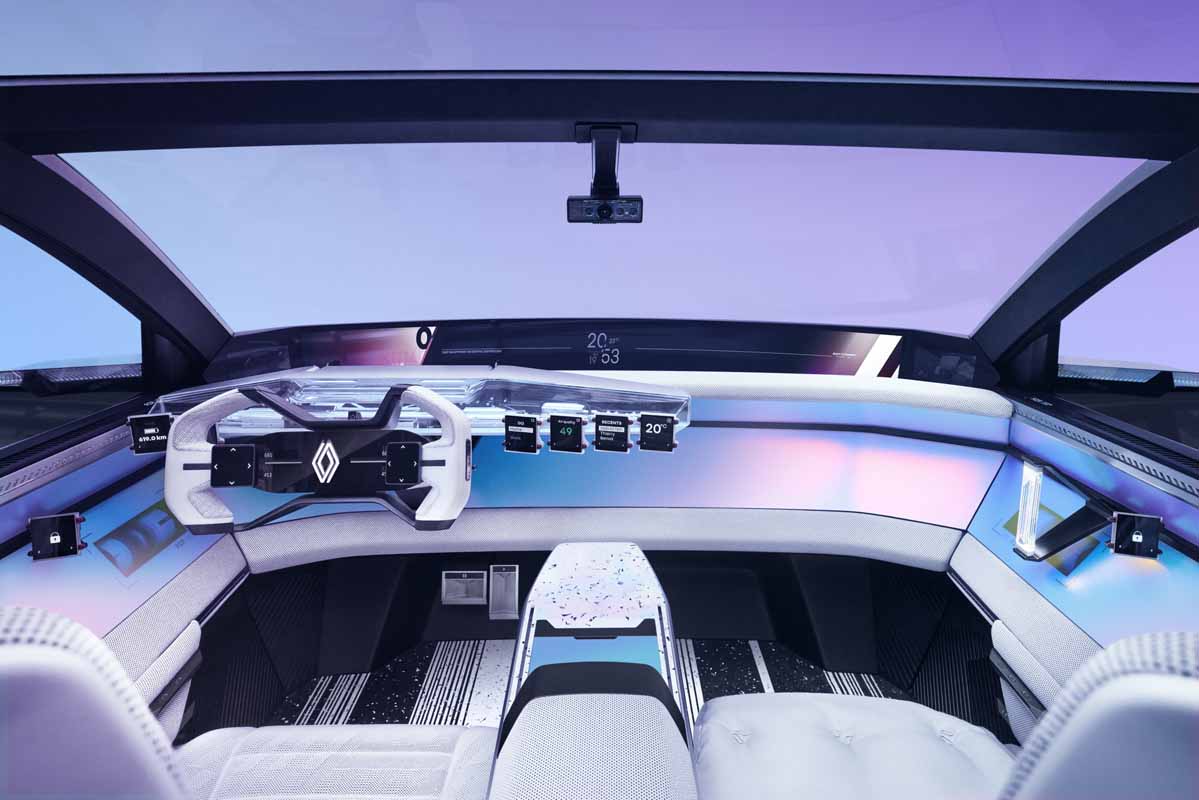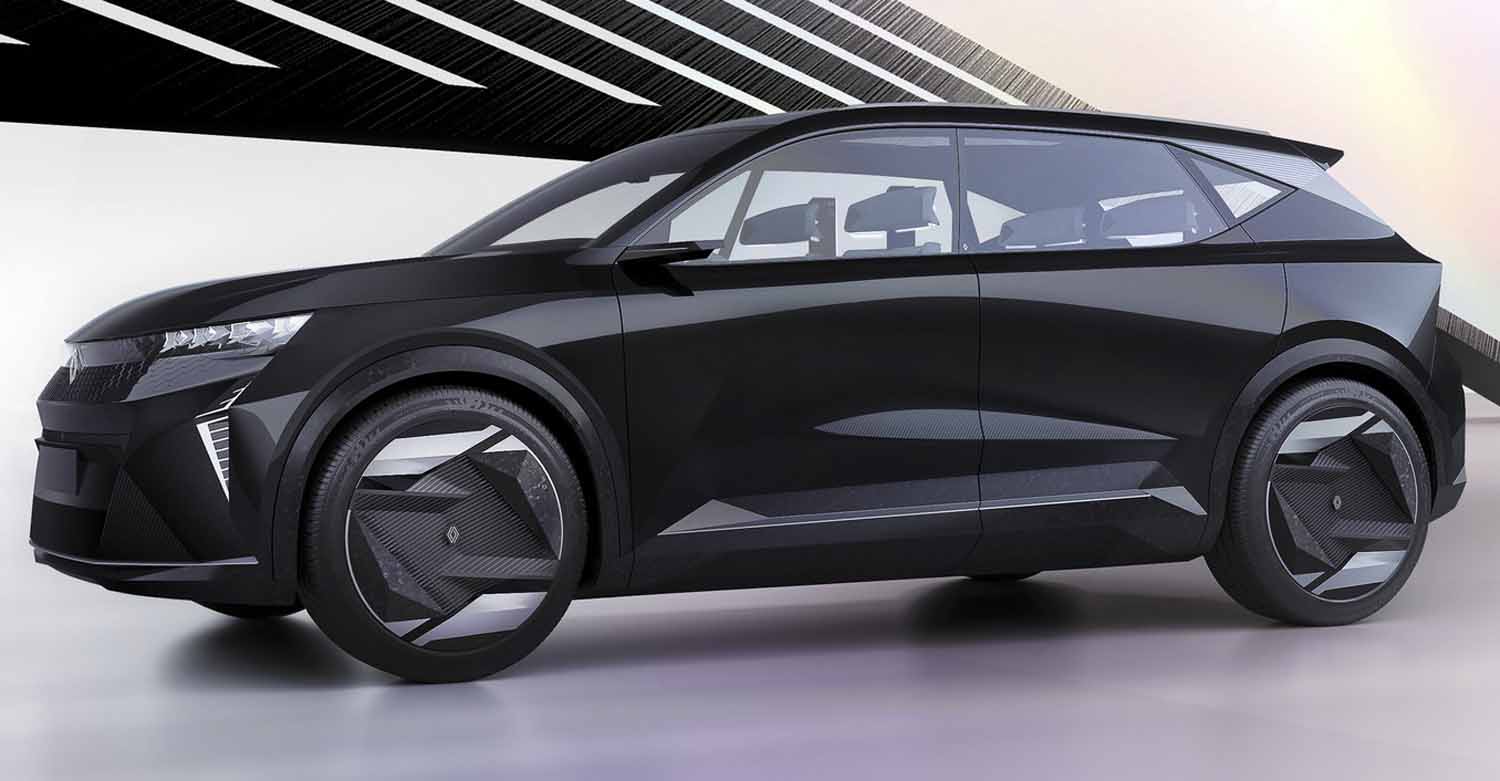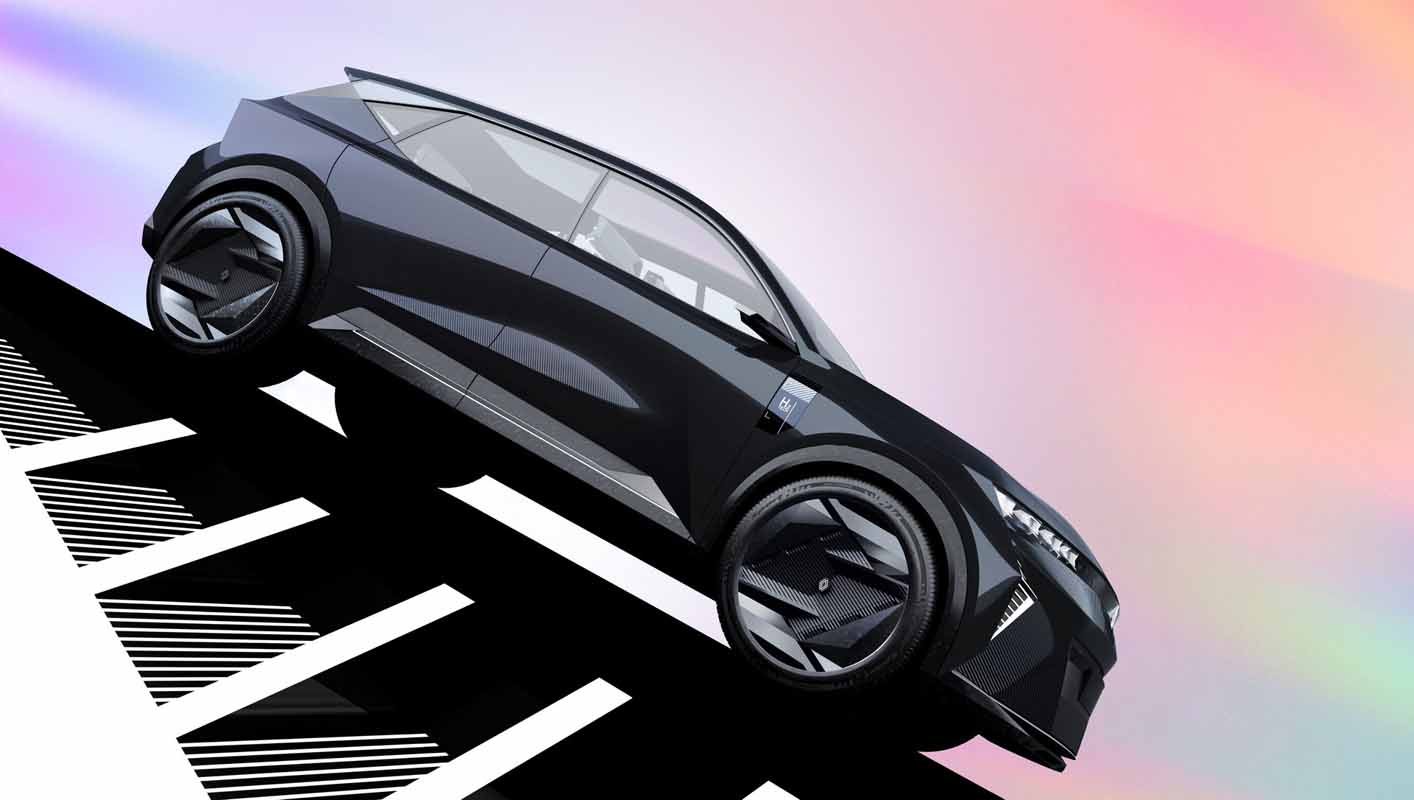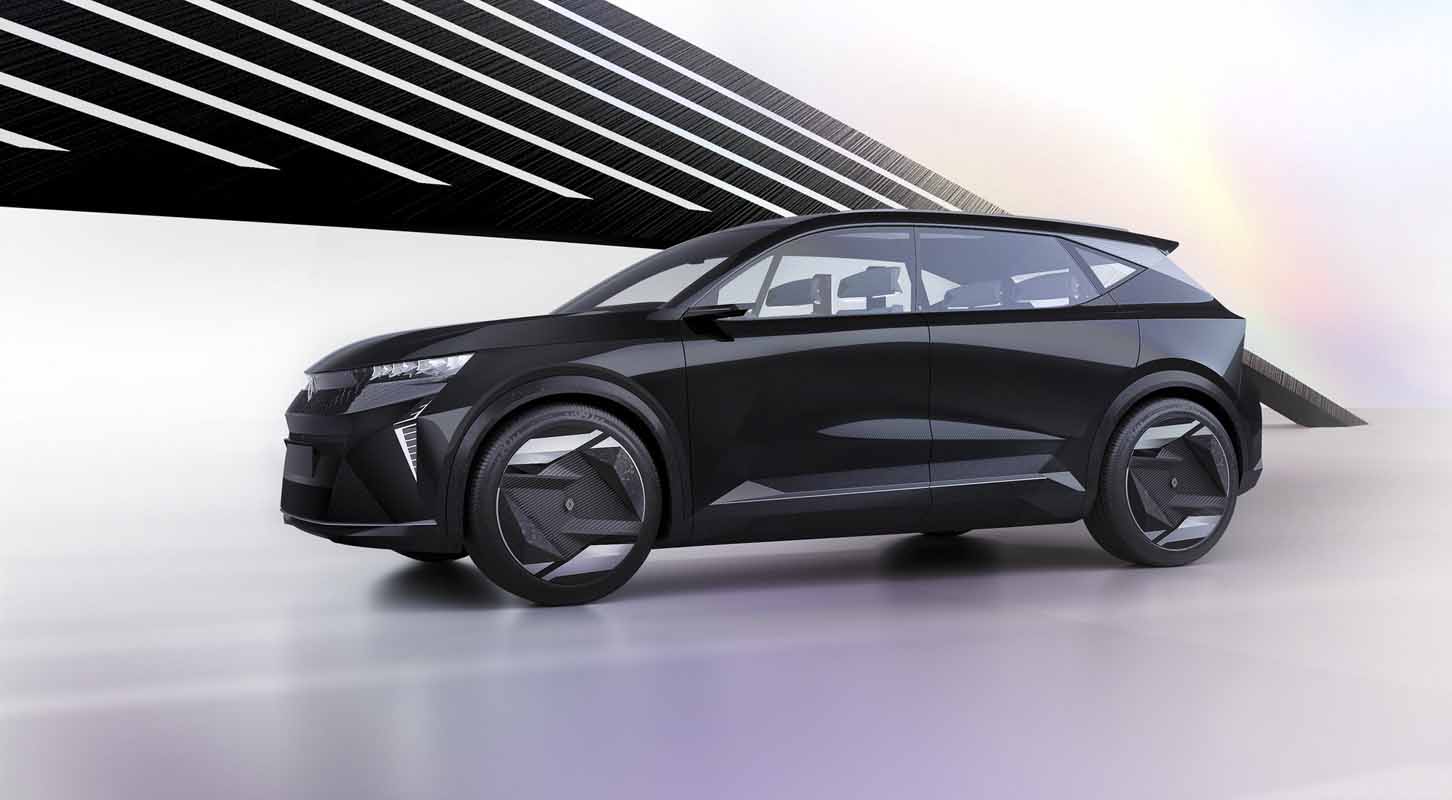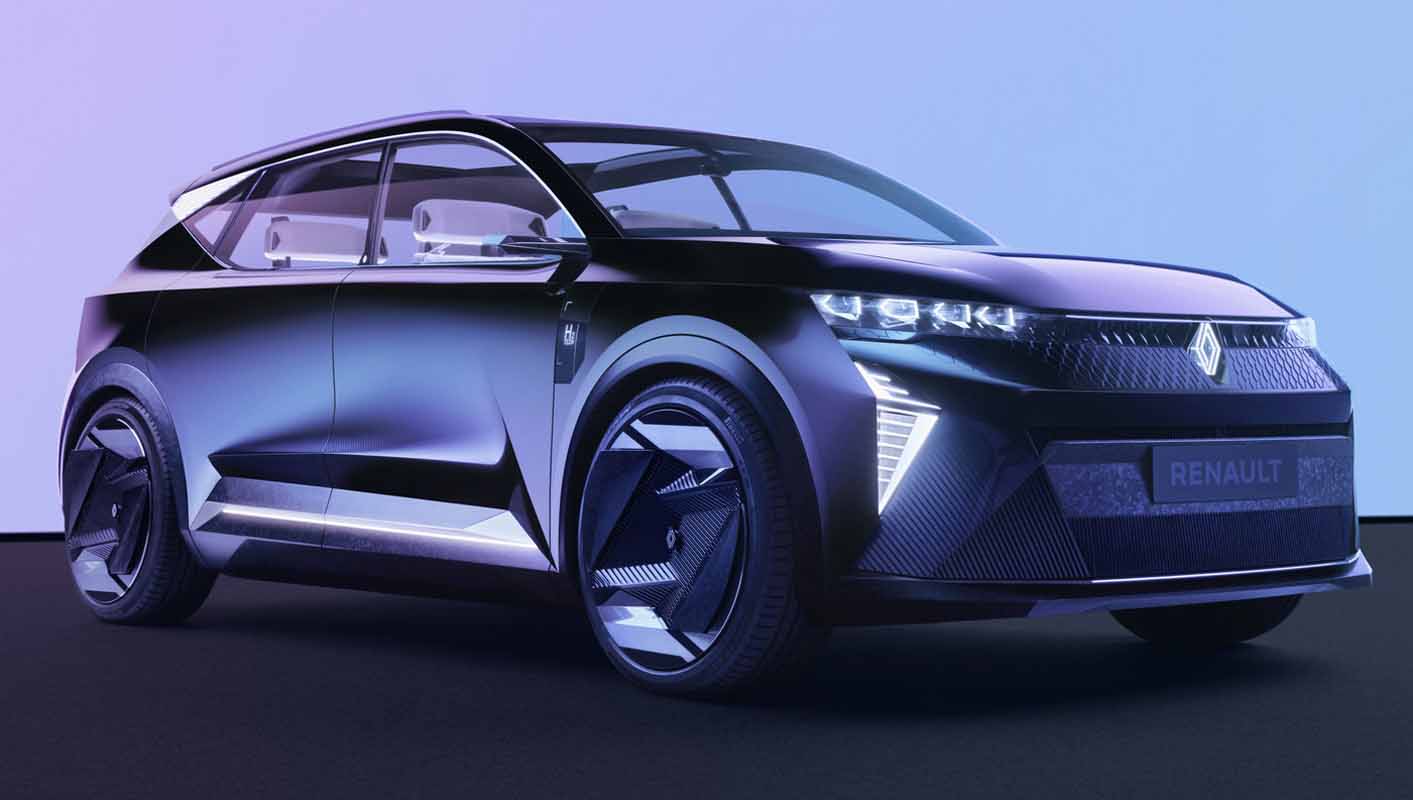
The automotive industry’s transformation will be more than complex: it will be total! The paradigm has shifted: the world is now aware that it is fragile. This applies to climate change as much as natural resources and the models underpinning society. There is a broad consensus around the need for change. The goal now is to turn this collective awareness into a motor for a greener, safer, more inclusive future. The challenges surrounding climate change, resource preservation and evolving mobility habits are radically reshaping the automotive industry’s value chain. Through its Raison d’Etre (Purpose) and its ongoing Renaulution strategic plan, Renault Group and its brands have embarked on an extensive transformation, shifting the focus away from volume and towards economic, environmental and social value, and have set their sights on carbon neutrality in Europe by 2040 and worldwide by 2050. To achieve this, the Renault brand is for example aiming for an entirely electric range in Europe by 2030. The Group, which was one of the first to venture into the electric vehicle arena over a decade ago, will do much more to advance decarbonisation than reduce emissions in use. Today Renault is unveiling its Renault Scenic Vision concept car, which embodies its sustainable development commitments and encapsulates them in a vehicle. It takes Renault’s decarbonisation plan and adapts it to the full life-cycle of a vehicle.
UNIQUE, SINGULAR, PLURAL: A PIONEERING CONCEPT CAR
Renault is writing a new chapter in its history with an innovative concept car that shows the way and brings the vision to life. Outside, it heralds the Renault range’s future all-electric family car. Inside, it invites travellers into a new time, into a future where technology and innovation will make the world more sustainable and more environmentally-friendly.
The Scenic Vision concept car is blazing a new trail to more sustainable, safer and more inclusive mobility. It is visionary and exploratory, it brings the most futuristic decarbonisation technologies to life today, and it embodies the three pillars of Renault Group’s sustainable development strategy: carbon neutrality, safety and inclusion.
- Its eco-design and its breakthroughs on the circular-economy front – 70% of its materials are recycled, in many cases in closed loops, and 95% are recyclable – contribute directly to resource preservation.
- It is a hybrid – electric and hydrogen – car that requires fewer and shorter stops. Its carbon footprint, including the battery, is smaller: Renault Scenic Vision is a zero-emission car (in production and in use) and its carbon footprint is 75% lower than that of a conventional electric car.
- The technology in the car enhances driver and passenger safety by reducing the number of accidents by up to 70%.
- This concept car’s design also mirrors the teams’ intention to create a car that is unique, accessible to all and right for everyone.
SUSTAINABLE DEVELOPMENT: SOLID, CONCRETE COMMITMENTS
At its 2021 Annual General Meeting, Renault Group detailed the sustainable development policy it is rolling out in its Renaulution strategic plan.
This bold policy is actively supporting the Group’s transformation strategy and its progress towards its performance objectives. It is based on three major pillars integrated into the company’s operations:
- Environment: the aim is to reduce carbon emissions throughout the vehicles’ lifecycle and reduce impacts on natural resources thanks to the circular economy. This end-to-end reduction – from cradle to use to grave – makes it possible to aim for carbon neutrality in Europe in 2040 and worldwide in 2050;
- User safety: we are fulfilling this longstanding commitment by analysing accidents, biomechanics and behaviour, and using findings to fine-tune the on-board intelligence that is making cars ever safer. Renault’s safety policy is based on a five-pronged approach: awareness raising, prevention, correction, protection, and rescue;
- Inclusion: to support new mobility habits and the technological shift in its industry, the Group is also upgrading skills and preparing the trades of the future. The company is also taking concrete measures to step up inclusion and better protect its employees by aiming for zero occupational accidents and zero occupational illnesses by 2030.
These commitments – which are contributing to transforming the Group into a greener, more high-tech enterprise that generates its revenues in new business fields revolving around data, energy and services – are the company’s Raison d’Etre in action. They embody its values of innovation and solidarity.
RENAULT SCENIC: THE CAR FOR LIFE AND FOR LIVING IS BACK
An invitation to travel. This was the first Scenic concept car’s promise, more than 30 years ago, in 1991. A promise that marked its time. Renault invented the compact minivan with a friendly family car that treated everyone to a one-of-a-kind travel experience, where memories from the journey lingered after you reached your destination. This “car of the future” also inspired today’s car. After four generations, Renault Scenic is reinventing itself; and this model is not just a silhouette, it is an experience like no other. With the new Renault Scenic Vision concept car, this car for life and for living is back and its invitation – to enjoy every second with your family, share every moment, while enjoying unparalleled comfort and optimum space inside – is still on.
Scenic’s original DNA is still there, but it has evolved. The world has changed over the past three decades. So has the automotive universe. The notion of travel has changed, travel habits have changed with it, the significance of cars is not the same, needs are changing shape. This concept car encapsulates a new vision for the family car. Its exterior design provides a preview of an all-electric model that will be unveiled in 2024. This C segment vehicle designed for long family journeys will come with all the advantages of the CMF-EV platform, plus take well-being on board to new s.
Tapping into 30 years of experience, the new Scenic Vision concept car is more than a car: it is a vehicle for a vision. A vision of a more protected environment, a leap forward for safety and the next level of inclusion. These commitments made by Renault contribute to sustainable and inclusive mobility, to mobility that intertwines driving pleasure, accessibility for all and environmental preservation.
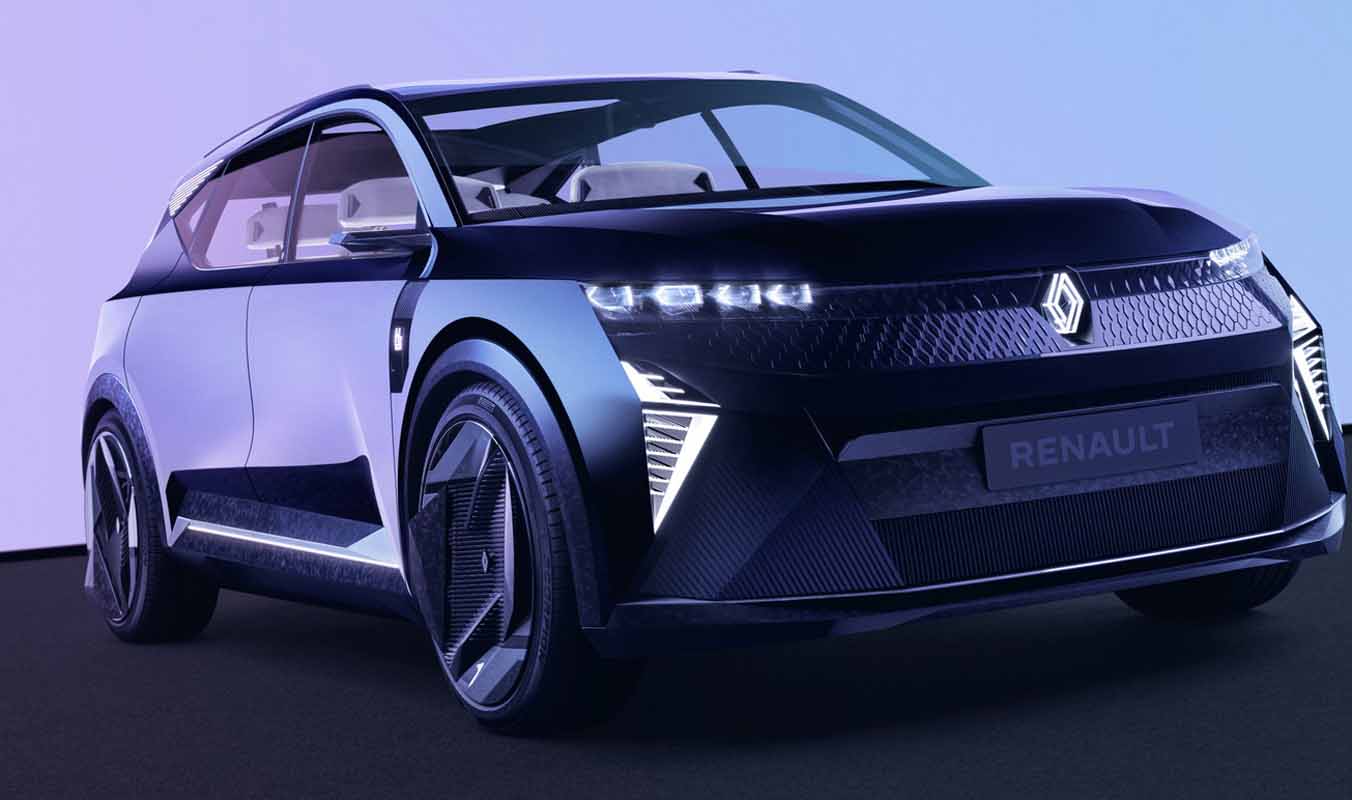
CARING FOR THE CLIMATE
There is now a broad consensus around the magnitude of the climate challenge and the urgent need for collective action. Renault Group is aiming for carbon neutrality throughout its operations in Europe by 2040 and worldwide by 2050. It is progressing towards this goal with a strategy that involves all its stakeholders. In other words, it is reducing carbon emissions across the board: through the materials and components it buys, the processes at its production sites, its cars’ emissions on the road, their second life and their recycling process. The vehicle’s entire lifecycle has been optimised to meet this ambitious objective, which dovetails beautifully with the era that is dawning for mobility.
Renault Scenic Vision captures this view of decarbonisation with a zero-emission power system, low-carbon materials and responsible manufacturing processes in carbon-neutral plants. Renault Scenic Vision is aiming for a 75% smaller carbon footprint than a conventional electric vehicle.
HYBRID POWER: ELECTRIC PLEASURE FACILITATED BY HYDROGEN
Transport accounts for 23% of CO2e* emissions worldwide, and 45% of those emissions come from passenger travel on roads. Renault, which has been spearheading electric mobility in Europe for more than 10 years, is looking into alternatives to address the full range of mobility requirements. The Renault Scenic Vision concept car is powered by a one-of-a-kind hybrid – electric and hydrogen – propulsion system. It has a new-generation motor-engine, a smaller battery, with a smaller carbon footprint, and a fuel cell running on green hydrogen. And it is ushering mobility into a completely new age, which the Group believes is viable for the coming decade.
“It’s not just carbon dioxide (CO2) but all greenhouse gases that are the root cause of global warming. In order to expresses a carbon footprint with a single unit, all other greenhouse gases are converted into CO2 equivalents otherwise known as ‘CO2E’ (or even ‘CO2EQ)”.
A customised powertrain
Renault Scenic Vision’s 160 kW electrically excited synchronous motor derives directly from All-new Renault Megane E-TECH Electric’s motor and is made at the plant in Cléon. It uses no rare-earth elements, which helps to reduce its carbon footprint and create a responsible and sustainable ecosystem. The 40 kWh battery is recyclable and will be made in France by 2024 at the Renault ElectriCity Gigafactory. It is two times lighter, smaller and actually costs less than a battery for a similar electric vehicle. And it has a 16 kW fuel cell to recharge it during long drives and thus extend its range. In 2030 and beyond, once the network of hydrogen stations is large enough, you will be able to drive up to 800 km – or, for instance, 750 km from Paris to Marseille – without stopping to charge the battery. You will only have to stop for 5 minutes or less to fill the hydrogen tank. So, once you leave Paris, a 5-minute stop in Lyon, say, will be enough to reach Marseille.
A singular and specific platform to include hydrogen
Renault Scenic Vision has an all-new platform that is purpose-designed to fit all the components: the electric motor, hydrogen engine, battery, fuel cell and hydrogen tank. The engine is at the rear, so there is enough space for the 2.5 kg hydrogen tank at the front; the fuel cell is under the floor, at the back of the platform, behind the battery.
Optimal travel times
This propulsion system’s operation of Renault Scenic Vision is simple and efficient. You can drive the car as a conventional electric vehicle, without using the fuel cell, on your daily trips. Then, when you want to travel longer distances, the use of fuel cell it’s privileged because it’s quicker to top up the hydrogen tank than to charge the battery. A “route planner” calculates the power that the fuel cell needs to supply to keep the battery charged for longer, so that you don’t have to charge it on the way.. That way, you don’t have to charge the battery until you park the car at your destination. When the weather is cold, the hydrogen range-extender also keeps the battery at the right temperate for optimal operation and extra range.
Unrestricted driving
Renault Scenic Vision’s hybrid electric and hydrogen powertrain has all the advantages of electric driving : instant acceleration, less noise and no vibration. Hybrid electric and hydrogen technology complements the all-electric range, with the advantage of shorter stops and a smaller carbon footprint, making it perfect for long journeys with your family. And, as it runs on green hydrogen, this car is a perfect fit for Renault Group’s objectives for decarbonised mobility. And no pollution, because the car discharges nothing but water when you use it. There are several advantages to this platform and this new kind of propulsion system: you can drive long distances only stopping briefly to fill the hydrogen tank (roughly every three hours) and they provide an appealing alternative to all-electric motors – even though they are still in the exploratory phase.
Clean energy and simpler use
Several systems to complement electric motors are being explored today to address the requirements associated with long-distance driving. Hydrogen technology is one of the options to make electric vehicles more convenient. Renault is working on this technology in light commercial vehicles with Hyvia, the Group’s joint venture with Plug Power to advance hydrogen mobility. Renault is also looking into the possibility of using this technology in passenger cars, once it has cleared that milestone with LCVs, using the hydrogen station networks that will be built.
The goal of providing this versatile combination of electricity and hydrogen is to shrink the vehicle’s carbon footprint while covering the full spectrum of requirements. The fact that the hydrogen is green – i.e. made with renewable energies, releasing no CO2e -, means that users can enjoy the added convenience and the smaller carbon footprint. As green hydrogen production is sustainable, it can be used as a source of clean energy for a variety of purposes, notably mobility.
ZERO-CO2E PRODUCTION: A RESPONSIBLE INDUSTRIAL ECOSYSTEM
Do more with less: that, in a nutshell, is Renault Group’s approach to reducing CO2e emissions throughout its vehicles’ lifecycle. It has made this pledge alongside its suppliers, so everyone in its value chain is aiming for a responsible and sustainable ecosystem together.
Carbon-neutral plants
Renault Scenic Vision was designed for local and responsible production in low-carbon plants. The three plants in the ElectriCity hub will be carbon-neutral by 2025 and all the plants in Europe will follow by 2030. The Flins Re-Factory will be Europe’s first plant dedicated to the circular economy. It is planning or has already started up a variety of operations at its workshops including vehicle refurbishing or retrofits, and part, material and battery recycling. This is extending vehicles’ lifecycles and helping to reduce carbon footprints.
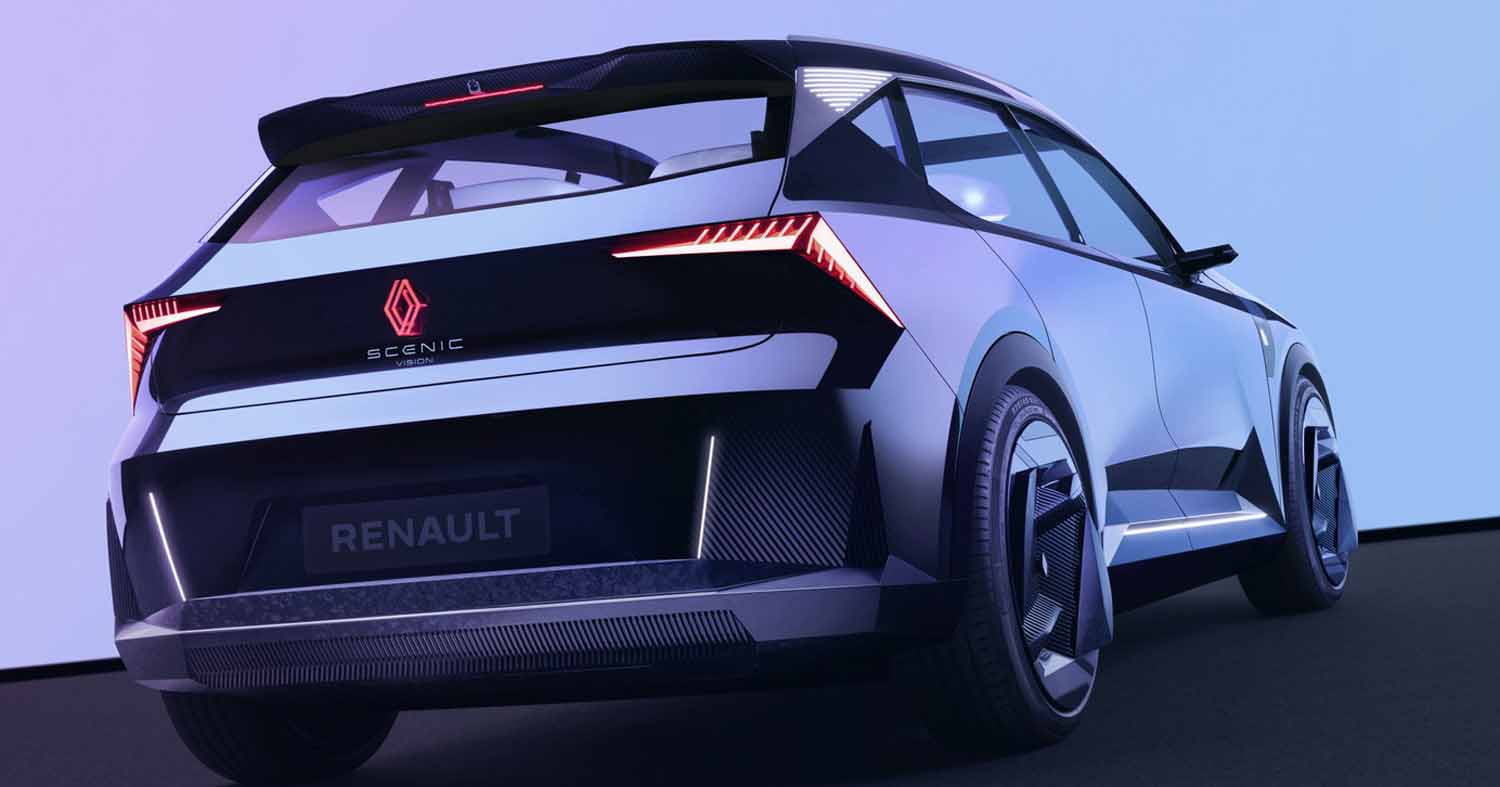
Lower-carbon batteries
Renault Group is developing green, low-carbon and responsible batteries. It has rearranged its entire value chain to preserve resources and cut carbon emissions. The Renault Scenic Vision concept car is tapping into all the options that have been identified so far through the strategic partnerships that Renault Group set in motion in the past. The aim is to reduce the batteries’ carbon footprint by 60%, both by decarbonising the energy used to assemble them and with a more responsible supply chain.
- Sustainable supplies of nickel, through the strategic partnership with Terrafame to source low-carbon, fully-traceable nickel sulphate. With this agreement, Renault Group will secure a significant annual supply of nickel sulphate from Terrafame, representing up to 15 GWh of annual capacity.
- Sustainable supplies of lithium, through the 5-year strategic partnership with Vulcan Energy, within the Zero Carbon Lithium™ Project, to source 6,000 to 17,000 metric tonnes of battery-grade lithium per year;
- The battery Gigafactory, which will be set up in the ElectriCity hub in Douai by 2024, to enable local production and optimise logistics;
- Closed-loop recycling of strategic materials (cobalt, nickel, lithium) to produce new batteries: 80% of the strategic materials used to make new batteries in 2030 will be recycled.
Lower-carbon materials
Extraction of raw materials and production of parts accounted for 15% of the carbon footprint of Renault Group vehicles in 2020. So embarking its 15,000 suppliers on a campaign to reduce that environmental impact is one of the strategic priorities.
Six materials and components add up to 90% of the carbon footprint of purchases: steel, aluminium, polymers, electronic components glass and tyres.
By focusing efforts on these six materials and components between now and 2030, Renault Group aims to shrink this carbon footprint by 30%.
CARING FOR THE RESOURCES
The Group aims to increase the percentage of recycled materials in new vehicles, relative to mass, to 33% by 2030.
Renault Scenic Vision is showing the way with unprecedented rates: more than 70% of its total mass is renewable and recyclable materials, and 95% of the materials in its design – including the battery – are recyclable*. This is a virtuous circle for the environment and for Renault Group. Component and battery dismantling and recycling activities, at the Flins Re-Factory and subsidiaries, will generate over €1 billion in revenue in 2030.
Resource conservation and recovery are deeply entrenched in this model. Renault Scenic Vision isn’t a one-off venture unrelated to the electric ecosystem. It’s the opposite: it is fully integrated and tapping into all the experiments that have been conducted in recent years. It has intelligent charging capabilities and in due course will be able to feed energy back into the power network using vehicle-to-grid (V2G) technology if needed. The know-how that Renault and the Group’s new brand Mobilize can pool, in battery management (second life, recycling, etc.), charging convenience and choice of charging options (at home or on the road) covers the entire cycle and value chain.
RECYCLABILITY: THE CONCEPT CAR THAT SHOWS THE WAY
A full 95% of this concept car’s materials – including the battery – are recyclable. This new approach to design looks beyond the vehicle and includes previously unexplored ventures and technologies. The exterior materials (steel, aluminium, carbon fibre and plastics) can all be recycled at the end of their life. Everything inside is designed responsibly. For example the foams, fabrics and stitching on the light beige seats are made of the same material, produced from fully recycled and recyclable plastic. They are easy to detach from the frames. As they contain no pigments, they are even easier to recycle.
Renault Scenic Vision is engineered to be environmentally-friendly, and easy to recycle at the end of its life.
A second life for the batteries
Estimates suggest that the number of electric vehicles on Europe’s roads will increase tenfold between now and 2030, from 10 million to 100 million. Renault Group is the first carmaker to work on the full battery lifecycle. It has thus developed solid expertise in increasing their durability and using them for a wider variety of purposes. Once a battery is no longer fit to power a vehicle, its energy can be reused in stationary storage solutions in homes or offices, or elsewhere (in boats, refrigeration systems, machinery or airport logistics, for instance).
RECYCLED MATERIALS: EMBRACING TRAILBLAZING PROJECTS
Smart management of resources and the way those resources are processed and integrated into a vehicle’s lifecycle are two major aspects of sustainable mobility. Renault Group was the first carmaker to invest in the recycling industry, when it set up its subsidiary Renault Environnement in 2008. Today, with the Flins Re-Factory, the Group is paving the way for a new industrial and commercial ecosystem that will elevate the circular economy into a game-changing business model. Its cutting-edge partnerships and groundbreaking technology projects put it in a position to maximise the use of recycled materials. The Renault Scenic Vision concept car is a case in point.
70% recycled materials
More than 70% of the materials in Renault Scenic Vision are renewable and/or recycled. It has for example adopted materials from the aviation or packaging waste industry. Creating this global ecosystem, where materials from various sectors are transformed to be used in new ways, is another step towards a more responsible and sustainable world.
This concern, however, is not new: Renault’s Ellypse concept car already mirrored the Group’s keen interest in the environment and sustainable development 20 years ago. It was made using recycled materials and designed so that the parts and materials would be easy to disassemble. Renault has never stopped innovating on this front over the two decades since then. New projects are weaving their way into cars and Scenic Vision is packed with the leaps forward and industrial breakthroughs since then. And it has metrics to show it!
-
Low-carbon and circular steel
- All the steel parts are manufactured using low-carbon energies;
- The steel in the vehicle’s structure is made from 95 % recycled steel, with a process involving an electric arc furnace;
- The steel in the body is made from 30 % recycled steel (frame, body sides, etc.) and is produced through a green hydrogen powered process;
- The steel left over from stamping operations in our plants will be recovered, compacted and fed back into the loop to make new coils, and thus new parts. The Group is already in a position to do this, through its subsidiary Boone Comenor Metalimpex, which specialises in scrap recycling.
-
Aluminium: 100% recycled
- All the aluminium parts in the structure (housings, battery casing, seats) and trims (console, cockpit) are made from 100 % recycled aluminium and only lightly machined;
- The doors are made from 100% recycled aluminium sheets.
-
Carbon fibre: sourcing from the aviation and papermaking industries
- The body parts and door sills are made from 100 % recycled carbon fibre from aviation industry scrap.
- The hydrogen tank is made of 100 % recyclable and renewable carbon fibre produced from paper-industry waste.
-
Interior and exterior plastics: 70% recycled
- Renault Group has been using recycled plastics in its vehicles since 1995, but this proactive approach reached a whole new level in Scenic Vision, which has an unprecedented 70% of recycled plastics inside and out (seats, floor, bumpers, etc.);
- The floor on the Renault Scenic Vision is made of 100% recycled plastics from food and industrial waste (45% milk bottles, 55% plastic pipes, etc.). An innovative project that seeks to recycle day-to-day waste while reducing the overall carbon footprint.
-
Leather-free
- The Renault Scenic Vision is entirely leather-free. Replaced with a low-carbon recycled polyester, this means lower overall CO2e emissions as it further champions the brand’s sustainable values. It has been replaced with low-carbon recycled polyester fabric.
-
Innovative pigments
- Colours are also one way in which the vehicle showcases an environmental ambition: black pigments are made using carbon fibres recycled from aeronautical industry by-products.
- Thanks to Air-Ink’s unique innovation, the paint used on the roof interior is made using urban particulate pollution, thus serving a dual purpose: improving air quality and recycling.
- Fabric used for the seat upholstery is a pigment-free off-white that can be easily recycled
-
Fuel cell: 100% recycled platinum membrane
- The fuel cell membrane is made of 100% recycled platinum taken from catalytic converters taken from combustion motor cars. Here again, the Group is already well equipped through its subsidiaries INDRA and GAIA, who are already implementing large-scale, closed-loop collection and recycling of platinum, rhodium and palladium from end-of-life vehicle catalytic converters and more.
- They are made primarily using bipolar plates that are 95% recycled steel.
-
Copper: 100% recycled
- All the copper used in the vehicle’s batteries and electrical cables is recycled from end-of-life vehicles and batteries and production waste. In leveraging know-how from its subsidiary GAIA, the Group is well placed to reduce the carbon footprint of its copper by 41% while also helping to preserve such a strategic resource.
-
Renewable materials
- Renault Scenic Vision is equipped with sustainable tires that meet the guidelines of the Global Platform for Sustainable Natural Rubber (GPSNR);
- This concept car includes 30% bioplastics from non-food sustainable sources.
- Electronics, battery, motor: no rare earths
CARING FOR THE PEOPLE
Provide assistance to drivers, enable them to better avoid risky situations, reduce stress behind the wheel while maintaining road awareness, and increase driving pleasure. This is what Renault promises with the new Renault Scenic Vision concept car, which incorporates technology and systems that will reduce the number of accidents by up to 70% when coupled with conventional safety equipment.
The Renault Vision Scenic adapts to the driver and not the other way around; designed to be inclusive, with an original push to be accessible.
Nowadays, aside from standard ADAS, there is a new of protecting people on board: enhancing the risk awareness of drivers, by encouraging and showing them how to drive more responsibly.
TECHNOLOGY FOR PEOPLE
The Renault Scenic Vision, designed for long family journeys, is the embodiment of a safe, inclusive, and accessible car, where there is a space for everyone. A space to share in moments with others, where everything is designed to offer maximum comfort for the driver and passengers alike. Ergonomics and accessibility are part of Renault’s DNA and this concept car brings it to life. Caring for everyone on board, leading them, while offering full comfort and freedom, is precisely what Renault Group and Renault strive to provide. The car is not a space of new rules, it helps drivers to improve and become more aware how they drive.
Human error combined with external factors – traffic, weather, infrastructure – accounts for 90% of all road accidents. One in two are due to human error alone (drunk driving, sudden onset ailment, distraction, or stress).
Detect risks, warn and guide the driver, and then, if necessary, act to avoid the accident: the multiple ADAS and three on board systems ‘Safety Score’, ‘Safety Coach’, and ‘Safe Guardian’, ensure extra safety for all, providing a unique level of both physical and psychological comfort. The car detects risky behaviours and encourages defensive driving practices.
Safety Score – responsible driving
Like this brand’s new concept car Scenic Vision, new Renault models will come with a ‘Safety Score’. Using data collected by sensors mounted on the vehicle, it analyses the driver’s driving style – acceleration, smoothness, speed management, and driver distractibility. It then gives personalised driving tips to each driver based on a safety score calculated at the end of each trip. It helps drivers improve how they drive and provides personalised advice on the various risks associated with their unique driving style. A customisable proactive system that informs and alters driving practices; it is made fun and incentivised through rewards that engage users with the new system. Drivers thus become actors of their own safety, while still harnessing the many on board safety systems.
Safety Coach – identified risks
A dangerous bend, a highly accident-prone road, a danger appearing… the ‘Safety Coach’ uses data taken from the surrounding environment and the car’s on-board navigation system to inform users of risks located on their route. Unlike equipment that helps prevent risks, the ‘Safety Coach’ gives drivers more room to plan ahead, avoid the risk, change speed to suit the specific situation (roundabout, dangerous intersection,), and take stock of the various visual, audible, or tactile warnings.
The data is an intelligent mix of input from the road, information from the navigation system, and updates of frequently encountered events shared between vehicles. People are given the most relevant information to avoid risks. Loud, stressful warning signals have been replaced by gentle, multisensory notifications, thereby enhancing the driver’s ability to anticipate, remain alert, and respond accordingly. The Safety Coach helps reduce the number of road accidents – fatal accidents included – by 30%.
Safe Guardian: detect and address a drop in awareness
Training and guiding drivers to adopt better driving practices helps reduce risk and stress and avoid accidents. However, in case of a real and present danger, connected on-board systems take over. This is the role of the ‘Safe Guardian’ that activates when there is a proven risk (dangerous turning, wheel not under uncontrol for a prolonged period, drowsiness, etc.). In such cases, the vehicle slows down and automatically brings itself back in control.
Interconnected vehicles
In the future, vehicles will interact in real time with their environment – between cars, between car and infrastructure, or between car and pedestrian – in order to warn occupants of potential dangers as soon as possible. Early management of unforeseen events will mean that such hazard warnings will improve via short-range communication. Unlike identified hazards, risks that are detected in real time (a vehicle that fails to stop at a red light) will be handled by technology that will act on interconnected. A whole ecosystem of communication devices will mean action can be taken before an accident occurs.
Fatigue monitoring
To further drivers, the vehicle comes fitted with an array of health monitoring systems. A heart rate sensor placed in the steering wheel and a camera serve to detect signs of driver fatigue or idleness. Should a problem arise, warning signals are sent to the driver and passengers.
Cocoon airbag
The Cocoon Airbag is house in the seats of Renault Scenic Vision and wraps around passengers in the case of an accident, it provides optimal protection while also freeing up space inside the car.
24 % more visibility
For total visibility and peace of mind, this concept car has been designed with a new architecture that features an extra-large screen located where the dashboard meets the windshield. It displays the car’s immediate environment thanks to an array of on-board cameras located at the front of the vehicle. This increases the driver’s field of view by 7° ; the windscreen is therefore 24% larger and it is as if the front of the bonnet disappears.
Post-accident safety: Fireman Access & Rescue code
New technological solutions help rescue services in the event of an accident. The Fireman Access and Rescue Code are two such systems already featured on production vehicles.
EQUIPEMENT FOR ALL
Ergonomics and inclusion. Those are the values embodied by the Renault Scenic Vision concept car. The design team of passionate men and women have worked on the car’s design with the ultimate ambition of creating a car adapted to all, where accessibility, comfort, and safety are its guiding principles.
-
Heightened Accessibility
- The suicide doors without a B-pillar make it easier to get in and out of the vehicle. There is no door lip to climb over.
- Lateral supports for the seats have been relocated to the inner door panel, thereby giving even more room to climb abord.
-
Ergonomic and adaptive cockpit
- The Renault Scenic Vision’s ‘responsive’ cockpit guarantees optimal comfort by adjusting to the driver’s morphology: it moves forward at the same time as the driver’s seat. Before getting into the car, seats are pushed back as far as possible in order to give passengers and the driver plenty of room to move about.
- The cockpit’s technological features are readily visible and each part interchangeable. This means that regular upgrades can be made over the course of the car’s life.
-
Facial recognition
- A facial recognition device located on the outside of the vehicle, near where the two doors meet, is used to unlock the car and automatically adapt the interior configuration (seat position, widget and app preferences, playlists…) to the person it recognises, making for a truly tailored driving experience.
-
10 configurable widget screens
- Adaptable and intuitive: 10 configurable screens are located throughout the interior of the Renault Scenic Vision. They are dedicated to different functions and are found in specific places of the vehicle.
- The cameras located in the front detects where people are looking and turn the screens to face the person seeking to interact with the system, meaning greater ergonomics and accessibility.
-
Interior soundscape with ened customisation
- Each seat is equipped with microphones and speakers to create a unique sound environment for each person and to ensure optimal communication on board as it can also amplify the voices of people speaking.
- No need to turn your head to chat with other passengers, the extra-large screen shows back-seat passengers thanks to the rear-mounted cameras.
-
Air purifier
- A HEPA air purifier (high-efficiency particulate air) located on the front doors of Renault Scenic Vision provides optimal air quality while also filtering out allergens often found in the car’s interior. Once the vehicle is parked, the systems also filters air from outside, thereby also helping to improve air pollution.
DESIGN THAT PAVES THE WAY FOR NEW PERSPECTIVES
A true embodiment of the Renaulution and illustration of Renault’s ‘Nouvelle Vague’, the Renault Scenic Vision concept car is the culmination of extensive design work and bold aesthetic choices. Its design thus gives insight into the future Renault vehicle line-up. The exterior silhouette reflects the shape and style of a new family model that will be hit the market in 2024. Its interior design is a leap into the future of what Renault interiors may look like one day. Its electric-hydrogen hybrid engine reflects Renault’s desire to find something for all possible uses, and sheds light on a much broader vision, one beyond 2030. This design paves the way for new perspectives, that of a world where cars and humans champion shared same values of a more sustainable mobility.
This unique design reflects the desire to build upon the brand’s historical values. Renault is an altruistic, generous brand, rooted in empathy and the living world, a truly humanist brand. This concept car reflects the ambition to create a car that brings people together, a car for living, with generous lines and features that enhance the on-board experience. But it is also future-looking, with a modern style, high-tech lines and an intelligent interior that is adapted to all. This unique concept car places the needs of users in terms of mobility, safety, and inclusion at the heart of creation, and not the other way around.
GENEROUS CURVES, STRONG CHARACTER
Measuring 4.49 meters in length (1.9 m wide and 1.59 m high), the Renault Scenic Vision is a family car whose dimensions are that of a C-segment vehicle. Its features boast a modern design with plenty of character and a sustainable underbelly. The Renault Scenic Vision is a mix of futuristic technology and styles, with an overall design built around the environment, safety, and inclusion.
A high-tech exterior design
As one comes close to the vehicle, a whole world opens up. Its generous curves pull you in; its strong lines underpin a futuristic, high-tech design, where elegance and personality unite. The vehicle boasts all the advantages of a family car: extended wheelbase, low belt line, large wheels, side and wheel-arch protective strips, horizontally aligned bonnet. Its proportions are ideal for optimised interior spaciousness.
The highly detailed front end of the Scenic Vision concept car features sculpted surfaces that converge in a dynamic flow of clearly visible lines; it is enhanced by a spectacular welcome sequence during which the front bonnet gives way to a flash diamond-shape animations that come alive on the grille before rising up around Renault’s new ‘Nouvel’R’ logo.
The body silhouette expresses strength and movement, and underpins the vehicle’s ever-changing surfaces as new ones arise. Close attention to detail can be seen in the rims, bumper air intakes, front grille components, rear-view cameras, and more; everything has been done to showcase the car’s HD design. The rear 3D logo further underpins the graphic style as it sticks out slightly from the rear hatch, giving it a greater sense of depth.
The lower door rims, wheel spacers, and front/rear skid plates feature a matte finish that is achieved using recycled carbon fibres. The combined effect of these details is that of a dynamic concept car with a strong sense of character.
A unique light signature
The lighting used on the Renault Scenic Vision is unique. It all starts with the logo that lights up in an array of colours. Their graphic language is modern and high-tech. The headlights and day lamps feature the same diamond shape as the logo, further showcasing consistency between the front end of the car and the brand’s image.
The rear quarter-window is framed by a clear outline of lights: thin lines light up to show tha car’s charge level, and to also indicate when the car is unlocked. The light is built into a colourless aluminium panel, and serves to underscore the new silhouette’s strong sense of character.
A car that adapts to those who use it
The facial recognition software serves to automatically unlock the car as the driver moves close. All it takes to open the doors is a simple touch of the tactile Renault logo located on the replacement B-Pillar. The suicide doors combined with the non-existent B-Pillar make for an easy-access compartment that reiterates the sense of safety and inclusiveness that guided the creative teams during the design phases. They open onto a sleek interior, where technology creates added comfort for passengers as it adapts to each individual’s specific use.
Fitted with large 21-inch wheels, the rims on the Renault Scenic Vision are equipped with flaps for enhanced aerodynamic performance, and therefore greater efficiency. When the car is in motion (≥ 10km/h), the flaps close to improve their aerodynamics; as soon as the car slows down and its speed drops below 10km/h, the flaps open for better cooling as the heat generated by the brakes can escape more readily. A specific mechanism has been added to keep the logos positioned on the wheels in an upright position when the Scenic Vision is in motion.
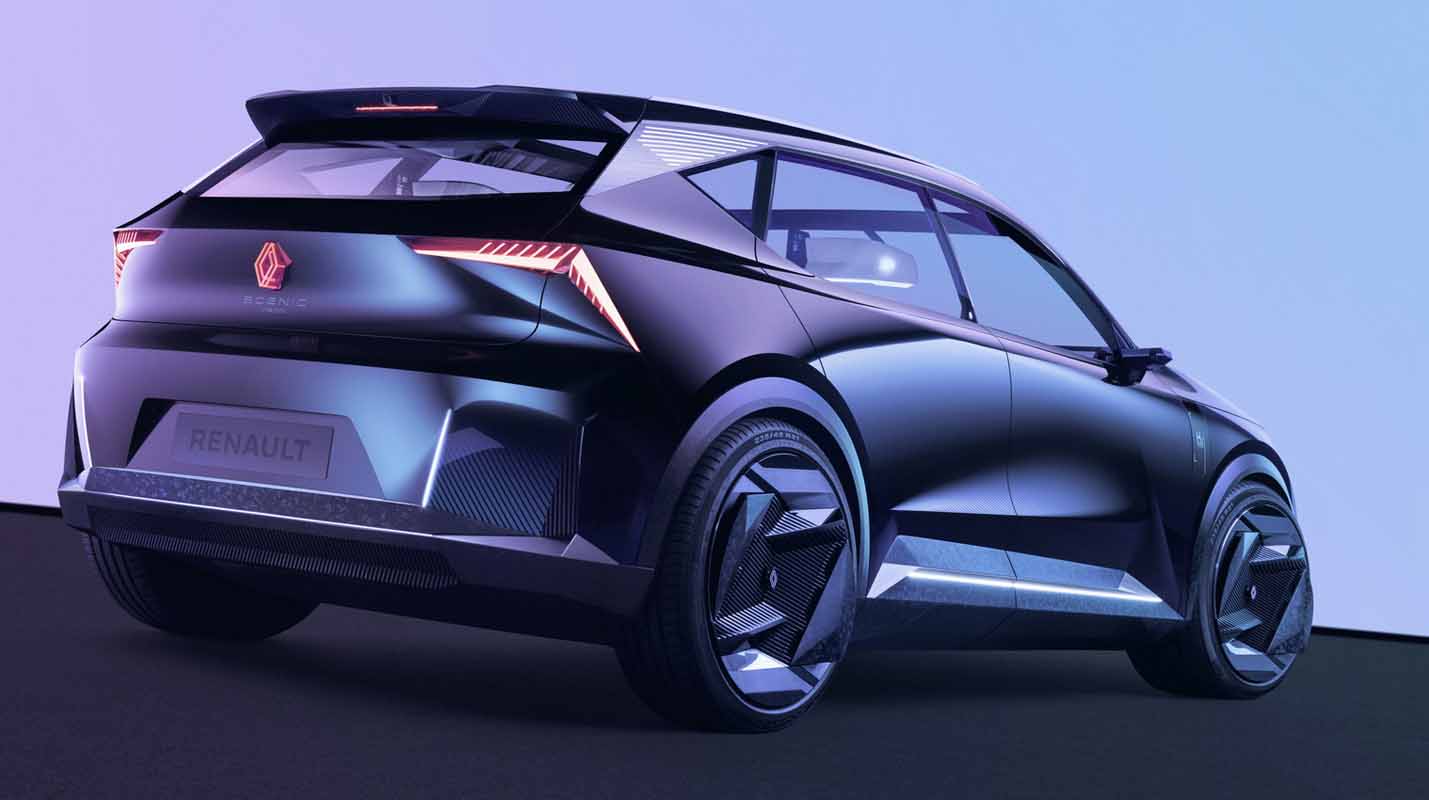
Inclusive and ergonomic interior design
The Renault Scenic Vision is more than a concept car. The original idea behind the car stems from a desire to offer sustainable, safe, and inclusive mobility. Its interior is a perfect realisation of the commitments made by Renault. The design teams devised a whole new architecture to create equipment that is accessible to all. Its interior adapts to each person on board; a truly visionary philosophy.
As such, when climbing aboard, the cockpit and seats move back, so as to give passengers and the driver maximum room to move around in. They then move back to a more suitable position by adapting to the morphology of each user. The seats have been designed to suit their primary function. The wrap-around driver’s seat is sportier than the others making it easier to stay focused on the road when driving; whereas passengers benefit from seats designed to be more comfortable, to travel in ‘First Class. The rear bench seat features two individual seats.
Well-being interior design
The LED-based coloured lights Appear throughout the interior for added on-board comfort. A reading light has been added to the front passenger door for greater reading comfort. Each head rest also features a LED light for added comfort and lighting.
The steering wheel is in the shape of a game controller, underscoring the interior’s modern ‘tech’ feel. Its sleek, simple design means its is very intuitive to use.
The centre console has been ergonomically designed. An induction charger for smartphones has been added to the lower part of the centre console, and a dock added to the armrest.
With the ‘Cocoon’ airbags now located in the seats, the dashboard is thinner and sleeker.
The Renault Scenic Vision comes equipped with a very large screen located where the windshield meets the dashboard, as close as to the horizon line as possible. The goal is to give the driver the best possible view. Its position maximizes ergonomics and safety by preventing the driver from taking their eyes off the road as they look for information which is displayed in two distinct areas: one for the driver, one for the passenger.
The vehicle’s large glass roof lets in light, inviting passengers to let their minds wander, and merging with the other glass panels to give a ened sense space and luminosity. This is enhanced by the choice of light-coloured, reflective materials.
In addition to the main screen, the interior also features 10 small widget screens, that are readily adaptable, intuitive and configurable:
- 4 widgets on the dashboard, to the right of the steering wheel, with the following functions to choose from: music, video, navigation, temperature settings, heart rate, pollution;
- 2 widgets on the dashboard, to the left of the steering wheel with the following functions to choose from: PRND (automatic gearbox) settings, door lock/unlock, battery level, and range;
- 2 widgets on the back of the centre console, and 2 widgets on the left and right of the front door panels with the following settings to choose from: seat position adjustments, door lock/unlock, power windows, interior lighting colour settings, music.
Content from the widgets can be transferred to the large screen on the dashboard, to everyone can safely share in those little moments of life.
A HIGHLY EXPRESSIVE GRAPHIC UNIVERSE
The unique design of the Renault Scenic Vision is ened by the choice of colours, where black and white create a singular graphic universe. Shades of black on the outside, and white on the inside, offer a contrast of lights and darks that reflects design team’s wish for this concept car to be a work of art where artistic expression takes the fore. This unique approach imbues the vehicle with a feeling of something timeless and universal.
On the outside, black hues are enhanced by an array of pigments and reflective paints that highlight the sculpted forms, where light and shape interact, giving rise to new surfaces.
Inside, the feeling of space and light is embodied by a predominantly white interior. Black highlights stand out on the structural features, encouraging a more intuitive use of the vehicle’s functionalities and a more user-friendly approach to the space. Colour is brought into the space through an ingenious idea: dichroic panels. Installed on door panels where they reflect light, they give off a rainbow of colour, without the use of pigments. The high-tech feel reinforces the interior’s graphic feel.
Finally, black and white are featured on the floor panels, creating a bridge between the interior and exterior.
Raw, recycled materials
The materials used have been carefully chosen. The balance between sustainable development and design matters is applicable at every stage with recycled, renewable, and bio-sourced materials, optimised manufacturing processes and natural finishes. The vehicle’s body is made using fully recycled aluminium, steel, and carbon fibre. Inside, many parts are also made with the same durable materials and metals (see details on page 18). Cockpit parts are made of 100% recycled aluminium and with a raw milling to reduce manufacturing time and favour a more natural look. The raw finish, where the manufacturing marks are still visible gives the overall look a uniquely sophisticated appearance.
Unique colours
The environment is very present in the way colours have been worked in uniquely innovative ways, such as the use of black paints made out of carbon fibres that are a waste by-product of the aviation industry. These pigments are used for entire sections of the vehicle’s exterior to highlight the modern, highly graphic feel. The headliner is also unique: created using particulates that come from urban pollution, it reinforces the design teams’ desire to create a concept car that is as unique as it is responsible and sustainable. Upholstery used inside the vehicle for the seats, consoles, and door panels is unbleached and uncoloured, which means less pollution and it is easier to recycle at the end of its lifecycle.
Seats worthy of high fashion
Going beyond the boundaries of automotives, seeking more inspiration and innovation. In designing of the seats, the design teams drew inspiration from the world of fashion to give a whole new feel to the vehicle. Head rests are inspired by clothing and sportswear styles, incorporating very comfortable fabrics and materials, and unique customization possibilities with the embroidered Renault logo. The merging of two worlds of fabrics and materials that coexist to give rise to a unique on board atmosphere.
TECHNICAL SPECS
- Length: 4,490 mm
- Width: 1,900 mm
- Height: 1,590 mm
- Wheelbase: 2,835 mm
- Rims: 21 inches
- Tires: 235/45 R21
- Weight: 1,700 kg
- Energy: electric-hydrogen hybrid
- Engine: 160 kW electrically excited synchronous motor
- Fuel cell: 16 kW
- Battery: 40 kWh

